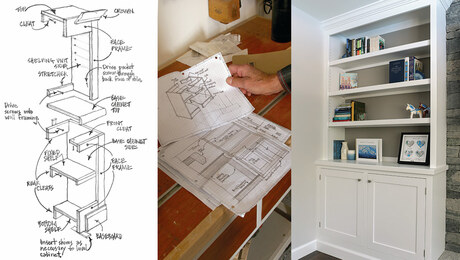threshold between tiles and wood floorin
16″ granite tiles in the hallway, 3/4 hardwood flooring in living, dining etc. Same finished level. Question: do I need a threshold? I guess this is a question of esthetics. The followings are the possibilities I can think of.
1. no threshold. Then where do I put the joints?
2. wood to match the hardwood flooring.
3. one piece granite to match tiles.
4. rectangular pieces cut from tiles, a cheaper option. Then where do I put the grout lines? Line up with the field tiles? Or offset symmetrically or asymmetrically?
Other possibilities?















Replies
Tom
The traditional place for dissimilar materials to meet is at the mid-point of the door -- the idea being that only one floor finish is visible from either side when the door is closed.
With two materials such as timber and stone I leave a 3/8" joint for expansion and fill it with colored flexible grout to match the timber.
As for a threshold -- you can get real fancy, like this
but I wouldn't bother unless it's the entrance to a major room and you want to make a statement
IDG
Edited 4/10/2002 5:23:35 PM ET by IanG
Hi Ian,
So what you are saying is no threshold? I can see if it is an archway the joint would be in the middle but if there is a door, shouldn't the joint be under the door which is to one side of the jamb? Is there such a thing as flexable grout? Or do you mean caulking? Thanks.
TomYes, the door will be to one side of the frame and there will only be enough room for a timber threshold if the door is to the marble side of the frame.By flexible, I mean a silicone compound or similar -- colored bathtub caulk, for example.By 'threshold' I mean a pattern in the floor, not a timber on the floor -- that, to me, would be a raised threshold and that traditionally is the whole width of the frame, not just under the door.
IDGIDG.
Yes Ian, we are talking about the same thing, a pattern on the floor not a raised threshold. So if the door is on the wood side of the frame, do you run the tiles to right underneath the door or put a thin piece of stone where the frame is? Also where the hallway enters the living room, the opening is framed by fluted pilasters and frieze band and plaster crown at the ceiling. It is as you said quite a statement. So Shall I put in a threshold?
Tom
TomRun the tiles to the center of the door.For the door at the junction of marble tile and timber, there's probably not enough room to get a pattern in the floor. For the other one -- Yes, why not make a statement with a nice pattern threshold?
IDGIDG.
Edited 4/10/2002 2:37:40 AM ET by IanG
Check with your floor supplier. They have lateral pieces to change direction and they also have a flush molding. I used it where my oak flooring met my granite hearth. You need 3/8 spacing and it fits in perfect. In my opinion If you start to turn tiles it will not blend with the rest of your design(like the beautiful job displayed on this discussion) He achieved the symmetry because the materials were modular and the angles and turns flow like a symphony. It is very difficult to accomplish that with dissimilar materials unless it was incorporated from the beginning of the design.
I'm with Ian. I did a floor a whiel back and had places where it met dissimilar materials. I left and expansion gap and filled it with a high quality caulk that matched the wood. The expansion joint was centerline in the doorway. I put masking tape on either side of the gap so I wouldn't get caulk over the stone or wood and then troweled the caulk in using a putty knife. I think it took two applications because of shrinkage, but I ended up with a nice joint that was flush with the both surfaces.
ChuckThere is a trick for caulking between a hardwood floor and a hard finish that's worth knowing. Save some really fine dust from the hardwood sanding and mix it with clear silicone caulk to give you a color to match the timber (albeit lighter).
IDGIDG.
Edited 4/10/2002 3:47:09 PM ET by IanG
Thanks. I'll use that one for sure.
Did you use a backer rod under the caulk? What kind of caulking did you use? Urethane, silicone, latex? Wouldn't silicone attract a lot of dust?
Tom
I didn't use backer under the caulk. In my case, it was hardwood joining up to Ceramic tile. The flooring was 3/4" think, but the tile was 3/8" thick with 3/8" ply under. The ply went all the way to the hardwood, so the gap I was filling was only the thickness of the tile; 3/8". I used Polyseamseal caulk.